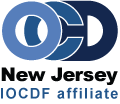Dr. Eric Storch, Ph.D. Presented on “Optimizing outcomes in OCD: Clinical complexities in treating youth and OCD tips for parents and professionals”
by Rachel Strohl, Psy.D.
On Sunday March 25, 2020, Eric Storch, Ph.D. presented at the 20th annual conference of OCD New Jersey (OCD NJ) and the 1st virtual conference. Dr. Eric Storch is Professor and McIngvale Presidential Endowed Chair in the Menninger Department of Psychiatry and Behavioral Sciences at Baylor College of Medicine (BCM). He serves as Vice Chair and Head of Psychology and oversees the CBT for OCD program at BCM. Dr. Storch has received multiple grants from federal agencies for his research (i.e., NIH, CDC), is a Fulbright Scholar, and has published over 14 books and over 550 articles and chapters. He specializes in the nature and treatment of childhood and adult obsessive-compulsive disorder and related conditions, anxiety disorders, and anxiety among youth with autism.
Dr. Storch began his talk by stating that obsessive compulsive disorder (OCD) causes impaired functioning and distress. There are two evidenced-based treatments for OCD: 1) cognitive behavioral therapy (CBT), which has multi therapeutic components, specifically exposure and response prevention (ERP). 2) Serotonin reuptake inhibitor medications (SRIs). He discussed the effectiveness of using CBT alone, and when it is recommended to use combined therapy and medication.
He discussed the predictors of CBT treatment response, including the following factors that impair treatment response: severity and impairment (higher), family accommodation (more), insight (worse), family history of OCD (1st degree relative), comorbidity, motivation (poor), family factors, and inadequate dose of treatment. Other factors that impair treatment include lack of treatment access, delayed diagnosis, incomplete treatment, inadequate treatment, or the wrong treatment. For example, acceptance and commitment therapy (ACT) can be used effectively within ERP, but not as a stand alone treatment. Dr. Storch reported from the studies that cognitive therapy alone with children is not effective, and the exposure element is key.
What can we do about it? Dr. Storch discussed the above points in detail.
- Severity and impairment of symptoms: extend treatment, increase family involvement, fill the gap, bring treatment into the home (e.g., telehealth), and make treatment more fun (e.g., exposure fingerpainted “contaminated” paint with children).
- Family accommodations: emphasis on bringing the family into treatment and getting them involved. It is important to integrate a reduction in family accommodations on the hierarchy, e.g., such as responding (or not) to reassurance seeking and confessing rituals, and using a token economy “to pay each for reassurance” and reward limits. Lebowitz et al. (2020) outlined the SPACE program, Supportive Parenting for Anxious Childhood Emotions: a) set the stage, b) increase supportive response, c) chart accommodations, d) pick target, e) plan and implement, and f) coping with difficult responses.
- Motivation: persuasion includes necessity (e.g., how does OCD help and hurt you?), possibility (e.g., highlight success rates and “kids like you stories”), and power (i.e., victim vs. survivor, passive to active). To increase motivation, Dr. Storch recommended following motivational interviewing (MI) strategies, e.g., reflective listening, open ended questions, elaboration, summaries, exploring goals/ values, and agenda/ goal setting. He also discussed the importance of rewards (praise and acknowledgement, bravery stickers/ tickets/ points, and reward menus), and making treatment fun (ERP as experiments and games).
- Comorbidity: important to assess a) if another disorder is secondary to OCD or caused by OCD, b) will treating OCD address comorbidity? c) is it distinct from OCD? d) will it interfere with treatment? If the other disorder is secondary, Dr. Storch recommended treating concurrently, staying focused on the goal, and extending the ERP model. If it is distinct and the other disorder will interfere, then sequential or concurrent treatment is recommended, or a higher level of care or infusing other evidenced based principles into treatment.
- P-factor: P represents a broad construct of psychopathology, including poor emotion regulation or disordered thought process. For instance, a person has a predictor to do worse in therapy if s/he/they have poor insight or overvalued ideation. Dr. Storch discussed how to address variable insight by building a narrative around the exposure (e.g., what will vs. what did happen?).
In the second part of the conference, Dr. Storch addressed determining the right level of care in OCD. The level of care is the dose of treatment. It can be titrated or maximized as a function of severity and need level of care can represent differing doses of treatment.
The following are things to consider when looking for intensive higher level of care: 1) OCD specialty, 2) length of stay, 3) additional treatment components/ schedule, 4) psychology and psychiatry integration, treatment models, and outcomes. Clinical considerations include: 1) role disruption, 2) severity and distress, 3) past treatment nonresponse, 4) comorbidity, and 5) family factors. Practical considerations include access, geography, timing, motivation, and benefit of conjoint treatment.
- Low intensity: self-help, online
- Standard outpatient: weekly CBT, medication management
- Intensive outpatient (IOP): about 2-3 hours/ day, 4-5 days a week. Usually comes after traditional outpatient.
- Partial hospitalization program (PHP): more than 5 hours a day a week. Hard to access without “failure” at lower levels.
- Residential: 24-hour care
- Inpatient: must meet stringent inpatient criterion
Dr. Storch discussed other higher levels of care including the neurotechnologies.
- Deep Brain Stimulation (DBS): demonstrated efficacy for movement disorders and OCD, with electrodes implanted in brain. There are promising results for younger patients with Tourette’s disorder, dystonia, etc. but not for children with OCD yet.
- Deep Transcranial Magnetic Stimulation (DTMS): originally developed for depression but need deeper stimulation for OCD.
Dr. Storch emphasized there is always hope for treatment. If first line treatments do not work, then there are higher levels of care that are effective and cost-effective options. He discussed the need for specialty programming and a matched level of care with clinical need.
The conference continued with an emotional highlight: the Living with OCD panel moderated by Dr. Weg. The panel consisted of the following individuals with OCD:
Brianna is a 25-year-old graduate student pursuing her degree in mental health counseling. She said her contamination OCD intensified in college and the obsessions focused on fecal matter and disgust. At her worst point of ritualizing, she spent over 17 hours in the bathroom cleaning herself and the bathroom after a bowel movement. She worked with other therapists but found an expert therapist in ERP and made progress, until she voluntarily admitted herself into an inpatient hospital specializing in OCD. She discussed the trial and error process with different antidepressants and antipsychotics, and has currently found the right combo. She proudly reported that she is so much farther along than she ever imagined, and now only spends 10 to 40 mins in the bathroom minimizing her ritualizes. She ended with a quote, “the only way out is through.”
Addie is a young adult and author. She stated having OCD “as long as I can remember but didn’t know it for 25 years.” Her obsessions focused on killing family members and her compulsions were largely mental, e.g., repeating on a loop of 3 to check she did not really want to do it. Her behavioral rituals including avoiding butterknives, tapping drawers, avoiding babies and the news. At the time of having her own baby, her OCD symptoms escalated but she found the proper treatment for OCD: ERP and now manages her OCD significantly better. She has learned that her thoughts do not mean anything and she can now live her life.
Madeline is a 14-year-old who has trichotillomania (trich), which is a body-focused repetitive behavior (BFRB) that is an obsessive-compulsive related disorder. She remembered pulling from her eyelashes and eyebrows when stressed in school starting in 4th grade. In 6th grade she started pulling from the top of her head and associated the pulling with school testing stress. She learned to use strategies in 7th grade including fidgets and wearing a headband to block the pull. In 8th grade she wore a hat to block the pulling and a bracelet that buzzed when she lifted her hand to her hair. She found telling her friends helpful and realized they did not care, and currently feels “mostly in control” of her pulling.
Rylee is a 16-year-old high school student who was diagnosed with OCD at age five. Her rituals included asking the same questions over and over, saying goodbye to her parents in an exact way, ritualistically folding clothes, and tapping in even amounts. She explained she was able to hide her rituals for many years, but by age 13, her obsessive thoughts increased about getting sick and fear of throwing up. Her rituals included washing her hands until they were very raw or covered in sores. Around that time, she started ERP therapy and learned, “I’m not going to die from this.” “I’d be ok if I got sick.”
Rich is a 41-year-old successful business owner. He was diagnosed with OCD at age 16 but experienced OCD and panic attacks at earlier ages. He discussed his obsessional theme as harm obsessions toward self and others. It got “the worst around age 23” when he refused his OCD medications. He went back on the medications and found more stability. When he had a baby, he experienced “constant anxiety” but began ERP therapy and “aggressively leaning into the fear.” A support group was also something he found helpful. Presently, he has been married 20 years and manages his intrusive thoughts, experiences lower anxiety, and feels functional. He discussed working on “not trying to control” his obsessions.
Diana is a 17-year-old senior in high school who was diagnosed last year with OCD, but noticed symptoms starting around age 11. She reported scary obsessions including “I hate god,” “am I the Christian Devil?” and feared losing her soul. She experienced intrusive thoughts 24/7 and engaged in rituals to prevent her obsessive fears. At age 16, she started ERP therapy and fought the strongest compulsions. She named her OCD Vanessa, started ERP by drawing a picture of her OCD, and writing an exposure story that consisted of a few scary lines. Other exposures were pictures of Satan around her room and agreeing with the fear that she would become a Satanist. She shared that ERP is difficult but works, and said she became desensitized to the fears. The ERP helped her to manage the fear and learn that she is strong, while rarely experiencing intrusive thoughts.
Each shared their courageous experiences living with OCD, and then audience members asked the panel questions about various topics. As in previous years, the panel members encouraged, educated, and offered hope to the individuals with OCD, their loved ones, and the professionals that treat them.
Dr. Rachel Strohl is a licensed psychologist at Stress and Anxiety Services of NJ in East Brunswick. She is on the Board of Directors at OCD New Jersey. She may be reached at 732-390-6694.

